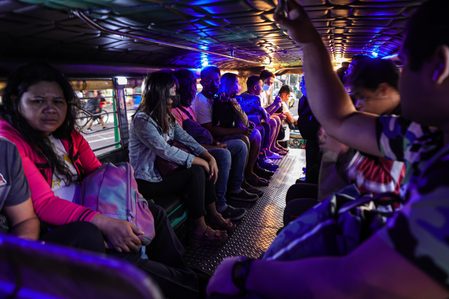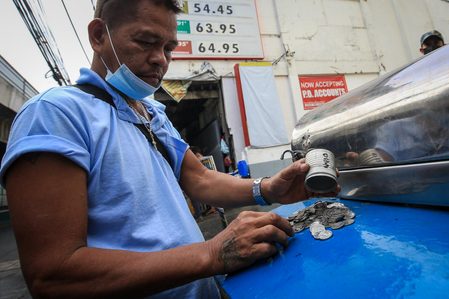SUMMARY
This is AI generated summarization, which may have errors. For context, always refer to the full article.

MANILA, Philippines – Sticking to its hard deadline for public utility vehicle (PUV) operators to consolidate, the government has been quick to defend the PUV modernization program as “effective.” But for some whose livelihoods revolve around jeepneys, they risk losing it all.
Currently, about 73.96% of jeepneys nationwide have consolidated, as of the latest count by the Land Transportation Franchising and Regulatory Board (LTFRB). In Metro Manila, that rate drops to just 51.34% of jeepney units. (READ: Gov’t denies job loss, higher fares even as only half of jeepneys in NCR consolidate)
What does this number say about the program? If you ask Transportation Secretary Jaime Bautista, it’s an indication that the consolidation deadline was “effective.”
“It is effective. It will be effective. We will make it effective,” he said along the sidelines of an event on January 5.
At this stage of the program, Bautista said the primary goal is to consolidate the industry, which would – ideally – make transport fleets more efficient and pool the resources of operators to be able to afford better jeepneys.
“Kailangan maging efficient ‘yung operations. Kung hindi tayo magko-konsolidate, we will continue to operate the way we operate: kanya-kanya, nag-aaway-away tayo sa kalye, hindi maayos, ‘yung walang standards ng operations, walang standards ng safety,” the transportation secretary said.
(We have to make operations more efficient. If we don’t consolidate, we will continue to operate the way we operate: every man for himself, fighting each other on the road, without any operational or safety standards.)
Several transportation officials have insisted that the number of jeepneys consolidated now will be “sufficient” to prevent any transport crisis from occurring.
“In DOTr’s study, we don’t need to get 100% consolidated. A 65% consolidation rate will be sufficient. That’s why the 70% nationwide rate that we’re seeing now, based on that, we’ll have to implement the program – but slowly,” Bautista said in a mix of English and Filipino.
Transportation Undersecretary for Planning and Project Development TJ Batan likewise defended the success of the consolidation deadline, saying that “more than a substantial majority” of PUV operators around the country consolidated.
“Since we were firm with the December 31 deadline, we think that, that contributed to that surge in applications catching up the consolidation,” Batan said on January 5.
As per the President’s directive, there will be no more extensions given to operators who didn’t consolidate by December 31, 2023. This means that as soon as February 1, 2024, tens of thousands of public utility vehicles could soon be off the road because of their failure to consolidate.
“Ang nag-uutos ng walang extension (The one that ordered no extension) is not me. It’s the President,” said Bautista. “Wala na (It’s done). The LTFRB and LTO will do the enforcement. Lalabas colorum sila, and ang colorum, ang laki ng penalty (They’ll effectively be colorum, and those labeled colorum will face big penalties).”
‘Not anti-poor’
The government maintains that the program will professionalize and uplift those whose livelihoods center around jeepneys. Consolidation – which involves operators banding together into either a cooperative or corporation – is the first step in the program. Once consolidated, routes will supposedly be “rationalized,” allowing for jeepneys to be deployed more efficiently, rather than drivers having to compete with each other for passengers.
“This is not an anti-poor program. In fact, with the implementation of the PUV Modernization Program, we will improve the lives of the drivers,” Bautista said.
Meanwhile, drivers affected by the consolidation requirement will not lose their livelihood because they can be absorbed by other cooperatives or corporations, who will “badly need” more manpower to serve their new routes – or at least that’s the plan.
“We were assured by the cooperatives na sila po ay tatanggap ng mga drivers doon sa operators na hindi po nag-consolidate (that they will accept drivers from operators that were unable to consolidate),” Office of Transportation Cooperatives Chairman Jesus Ferdinand Ortega said on January 5.
The plan is also for operators in consolidated entities to pool their money, share overhead costs, and get better terms on loans to buy new vehicles.
That’s important because down the line, operators will eventually have to upgrade their fleets into “modern jeepneys,” whose prices range above P2 million on average.
“Access to financing will be better if you are a consolidated entity. Your purchasing power will be better. Your negotiating power will be better in terms of acquisition of new vehicles,” Transportation Secretary Bautista said.
He also clarified that the government was in no rush to upgrade jeepneys, which could take anywhere from five to eight years to complete.
“Bakit ang kinakatakot ‘nyo ay kailangan mag-operate kaagad tayo ng modern jeep? Hindi naman eh,” he said. “Palagi namin inuulit na ‘yung modern jeep ay dadating ‘yan as there is fund to pay for it.”
(Why are they fearing that we’ll need to operate modern jeeps at once? That’s not how it’ll work. We always repeat that the modern jeep will come as there is fund to pay for it.)
‘Hit the pause button’
But if you ask some operators, drivers, and jeepney manufacturers, the PUV modernization program risks “phasing out” the iconic king of the road – and countless jobs along with it.
“Hit the pause button,” Elmer Francisco, chairman and chief executive officer of local jeepney manufacturer eFrancisco Motor Corporation, told Rappler. “You’re pushing the backs of the operators and drivers to the wall. They will fight for their lives.”
Francisco and his family have spent their entire lives building jeepneys decade after decade. But with the fear and uncertainty that the PUV modernization program brings, he’s seen firsthand how jeepney operators, drivers, and even his own workers have all lost their jobs.
“’Yung mga operators, mawawalan ng kabuhayan, ‘yung mga drivers nila mawawalan ng trabaho. Karamihan niyan, babalik sa probinsiya, magsasaka,” he said in an interview on Monday, January 8.
(Operators will lose their livelihoods, and drivers will lose their jobs. Most will go back to the provinces and turn to farming.)
“Ang daming nawalan ng trabaho. Ang daming trabahador ni Sarao na nawalan ng trabaho. Ang daming trabahador ni Francisco Motors na nawalan ng trabaho,” he added.
(So many lost their jobs. So many workers from Sarao lost their jobs. So many workers from Francisco Motors lost their jobs.)
Backyard assemblers, who may not have the capital to research and develop modern jeepneys, have been hit hard too: Melford, Armak, Wild Country, Hayag, and Morales Motors.
“Wala na, sarado na sila lahat. Wala na silang kabuhayan. ‘Yung mga trabahador nila, wala nang trabaho,” Francisco told Rappler.
(They’re all closed down. They have no more livelihood. Their workers, they have no more jobs either.)
Francisco also warned that not all cooperatives play fair. Some were dominated by “kingpins” who could demand up to P30,000 just for a driver – not an operator – to join the cooperative.
There’s the issue of ownership of units too. Upon joining a cooperative or corporation, the individual operator will no longer own his jeepney; instead, it is placed under the name of the entity. For Romeo, a jeepney driver along the Taytay-Shaw route, that was a dealbreaker. He told Rappler that he had no intention of joining a cooperative because he didn’t want to lose control over his jeepney.

“Paano ‘pag nalugi? Paano ‘pag hindi magaling ‘yung humahawak? Malugi ‘yung korporasyon? Talo ka,” he said back in February 2023, when talk of an impending consolidation deadline first began.
(What if they lose money? What if the ones handling us aren’t good, and the corporation goes bankrupt? You lose.)
Since then, some transport groups – led by Manibela and PISTON – have repeatedly taken to the streets, raising concerns about the difficulties of being “forced” into consolidated entities, as well as the high cost of modern jeepneys.
Regarding the latter issue, Francisco has already been working on an electric jeepney that could roll out as soon as the second quarter of 2024. More importantly, the first 1,000 units will cost just P985,000 – less than half of the average price of similar PUVs in the market.
Still, Francisco said that the government should dedicate a bigger budget to subsidize the cost of modern jeepneys if it expects operators to upgrade their fleets.
“Gusto mong palit jeepney. Pero ang budget mo is P1.2 billion. Kung P280,000 ang equity subsidy for each unit, that’s only 4,200 units. Tapos gusto mong palit ang 250,000 jeepneys?” Francisco told Rappler.
(You want to change jeepneys. But your budget is just P1.2 billion. If your equity subsidy per unit is P280,000, that’s only 4,200 units. And then you want to change 250,000 jeepneys?)
Congress investigates
Amid the controversies surrounding the PUV modernization program, the House of Representatives is set to hold an inquiry into the program’s implementation on Wednesday, January 10.
This comes after House Speaker Martin Romualdez instructed the House’s transportation committee to investigate the “corrupt practices that may have tainted the conceptualization and planned implementation” of the modernization program.
In a statement, Romualdez said that current transportation officials were “in cahoots with previous officials in negotiating for the imported modern jeepney units that will replace the old units.”
The House Speaker also appealed to the Department of Transportation to review the program and “extend the period of its implementation,” although he did not specifically refer to the consolidation deadline.
The Francisco Motors head also echoed this sentiment. In fact, when Romualdez approached him to ask for advice on how to deal with the program’s problems, he said to give it more time.
“Hit the pause button. ‘Yun ‘yung sinasabi ko kay Speaker Romualdez. Kung ayaw ng Department of Transportation, ayaw ng ganyan – kausapin mo na lang ‘yung pinsan mo (That’s what I told Speaker Romualdez. If the Department of Transportation doesn’t like it, or that one doesn’t like it – well, just talk to your cousin),” Francisco said, alluding to President Marcos. – Rappler.com
Add a comment
How does this make you feel?




![[Under 3 Minutes] When will we see modern jeepneys on the road?](https://www.rappler.com/tachyon/2024/04/francisco-motors-modern-jeepney-prototype-1.jpg?resize=257%2C257&crop=590px%2C0px%2C1012px%2C1012px)





There are no comments yet. Add your comment to start the conversation.